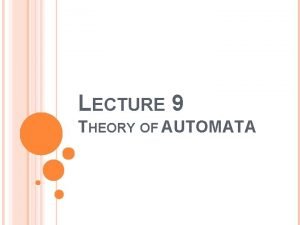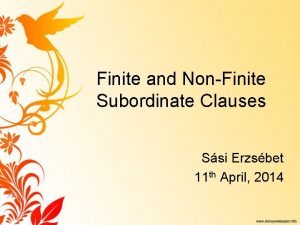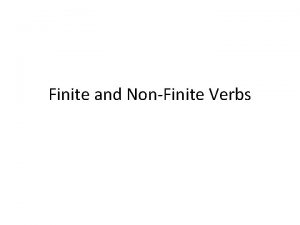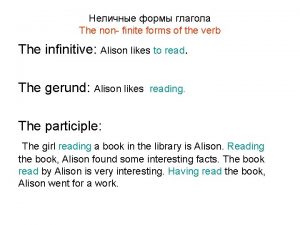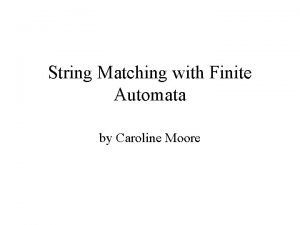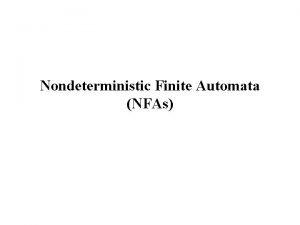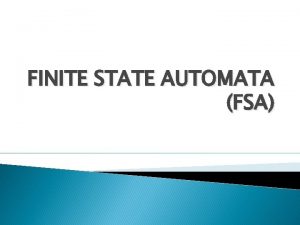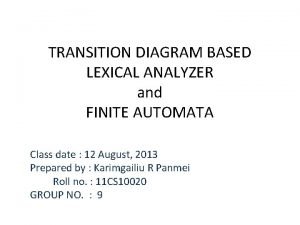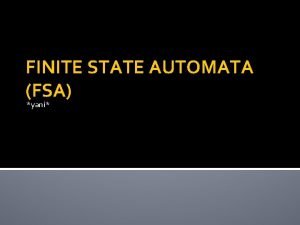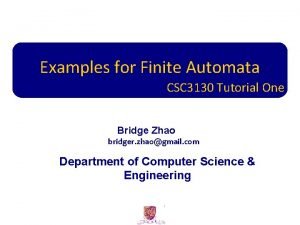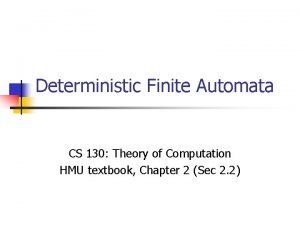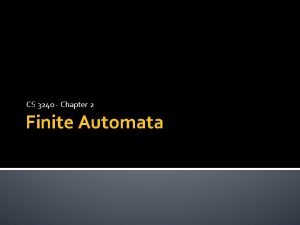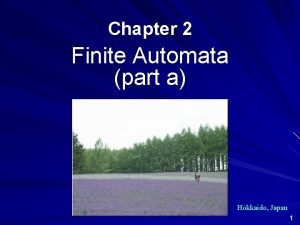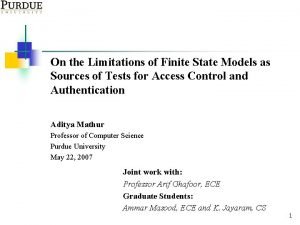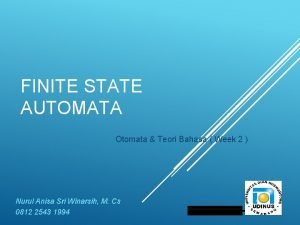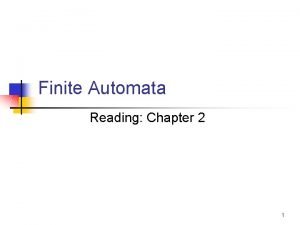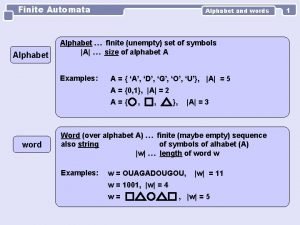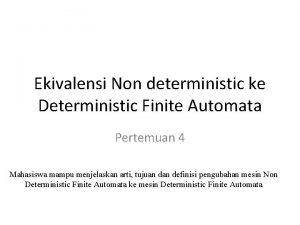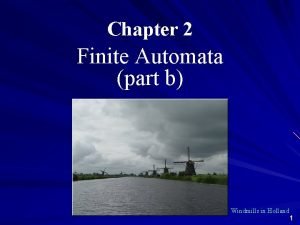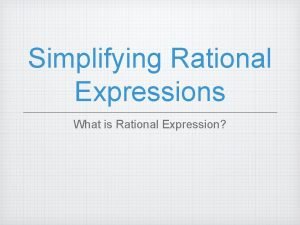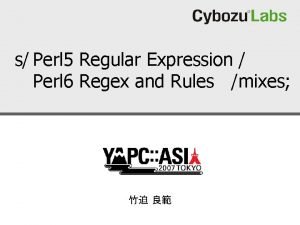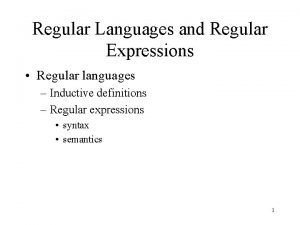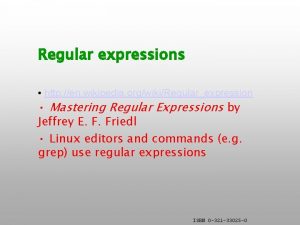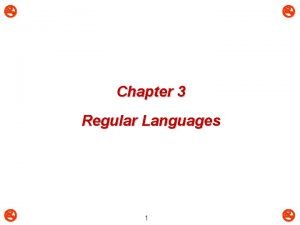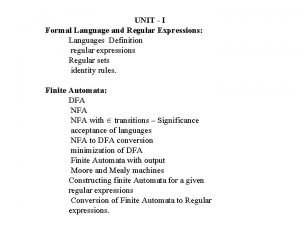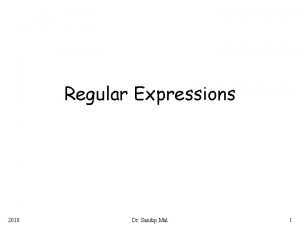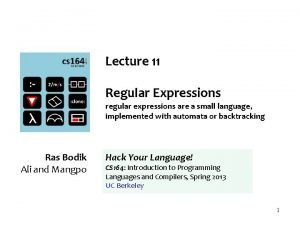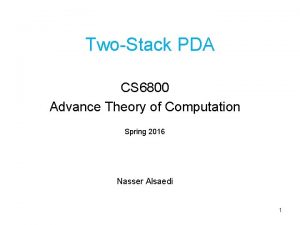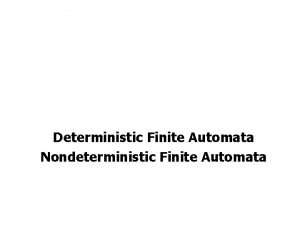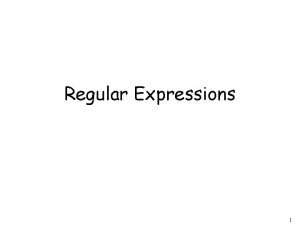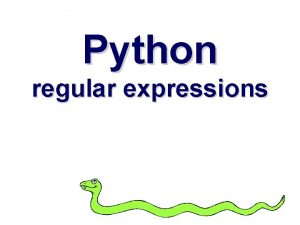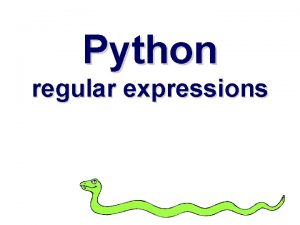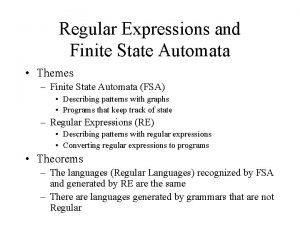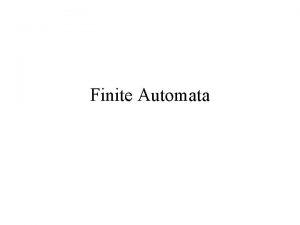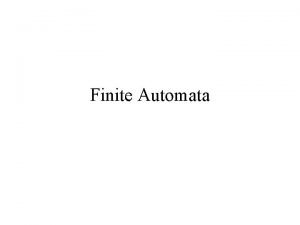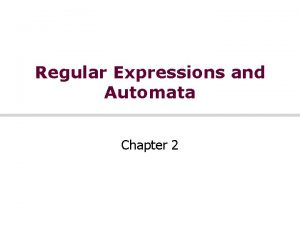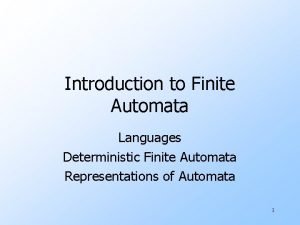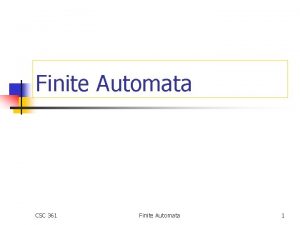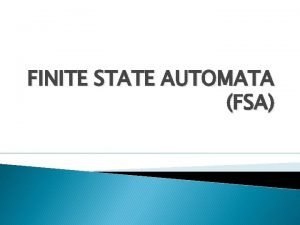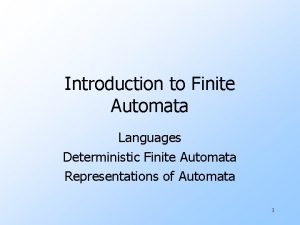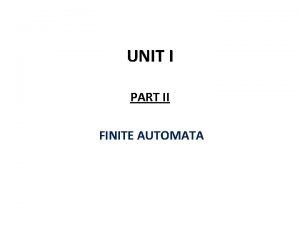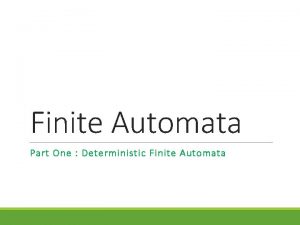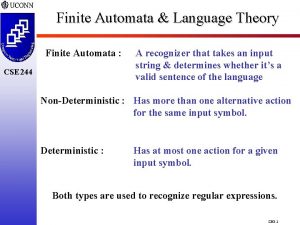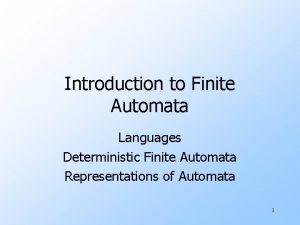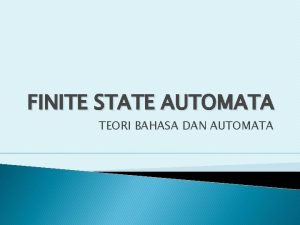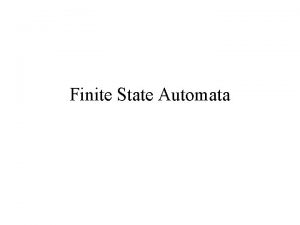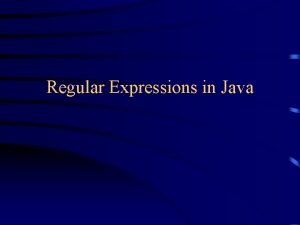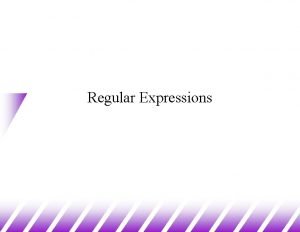Chapter two Regular expressions and Finite automata Regular




















![Eliminating ε-moves Let Δε* = Δ* ∩ [Q × {ε} × Q] be the Eliminating ε-moves Let Δε* = Δ* ∩ [Q × {ε} × Q] be the](https://slidetodoc.com/presentation_image_h2/5ef2b925c7677ca5e13008f2c6b2d57a/image-21.jpg)















- Slides: 36

Chapter two Regular expressions and Finite automata

Regular expressions A finitary denotation of certain kinds of infinitary languages over Σ. Bases: ∅ denotes L∅ = ∅ σ denotes Lσ = {σ} for any σ ∈ Σ Induction: r + s denotes Lr ∪ Ls r · s denotes Lr · Ls; r* denotes Lr* Notation: r is a regular expression which denotes a set of strings Examples: 6/8/2021 a(a + b)* All binary strings which contain 11. All binary strings which exclude 11. Theory of Computation: Chapter 2 2

Example Claim: (0 + 10)*(1 + 10)* is the language of strings in which every pair of adjacent zeros appears before any pair of adjacent ones. Justification: w ∈ (0 + 10)*(1 + 10)* implies w = w₁w₂ with w₁ ∈ (0 + 10)* and w₂ ∈ (1 + 10)*. Since (0 + 10)* cannot have double ones and (1 + 10)* cannot have double zeros we cannot have a 11 before a 00. So every double zero appears before any double one. 6/8/2021 Theory of Computation: Chapter 2 3

Continued Conversely any string w ≠ … 11… 00…, i. e. w = … 00… 11… with this property can be written w = xyz where x is the shortest prefix containing all the double zeros (i. e. ε or ending in 0 or 00) and z is the shortest suffix containing all the double ones (i. e. ε or beginning with 1 or 11). This is possible precisely because w satisfies the requirement of all double zeros before any double ones. Now see that y must be of the form (10)*. Since x ∈ (0 + 10)* and z ∈ (1 + 10)*, w = xyz ∈ (0 + 10)*(1 + 10)*, since (10)* is subsumed by its neighbors. 6/8/2021 Theory of Computation: Chapter 2 4

Identities ∅ is the additive identity: ∅·r = ∅ = r·∅ ∅+r=r=r+∅ ∅* is the multiplicative identity: ∅*·r = r·∅* = r where ∅* = {ε} r+r=r r*r* = r* (r*)* = r* r(st) = (rs)t r + s = s + r (r + s) + t = r + (s + t) r(s + t) = rs + rt (r + s)t = rt + st (r*s*)* = (r + s)* [HW problem] Hint: Regular operations are monotone: r ⊆ s ⇒ f(r) ⊆ f(s), where f is ‘*’, or ‘+ t’, or ‘· t’, or ‘t ·’. 6/8/2021 Theory of Computation: Chapter 2 5

Disjunctive normal form (DNF) Theorem: Every regular expression can be written as r₁ +…+ rᵢ where each individual term does not containing the ‘+’ symbol. Proof: By structural induction. The bases are trivial, as well as r + s. r · s = (r₁ + … + rᵢ)·(s₁ + … + sⱼ) by induction hypothesis. Use the distributive laws to finish. r* = (r₁ + … + rᵢ)* by induction hypothesis. Use the identity (r + s)* = (r*s*)* to show that (r₁ + … + rᵢ)* = (r₁* ····· rᵢ*)* follows by induction. 6/8/2021 Theory of Computation: Chapter 2 6

Deterministic finite automaton The input tape contains symbols from Σ. A read head moves left-toright across the input, and the state of the machine is in a finite control. Formally: �Q, Σ, δ, s, F�where Q is a finite set of states Σ is the (finite) alphabet δ : Q × Σ → Q is the transition function s ∈ Q is the start state F ⊆ Q is the set of final states 6/8/2021 Theory of Computation: Chapter 2 7

Example: parity Q = {q₀, q₁} Σ = {0, 1} q σ δ q₀ 0 q₀ q₀ 1 q₁ q₁ 0 q₁ q₁ 1 q₀ s = q₀ F = {q₀} 1 0 q₀ q₁ 0 1 (q₀, 01010) ⊦ (q₀, 1010) ⊦ (q₁, 10) ⊦ (q₀, ε) 6/8/2021 Theory of Computation: Chapter 2 8

Algorithm (operational semantics) q←s h← 1 while σ(h) ≠ blank q ← δ(q, σ(h)) h←h+1 If q ∈ F then accept Else reject 6/8/2021 {M begins in state s} {with head leftmost} {as long as head is reading a symbol} {change state} {move head right one symbol} {accept if we end in a final state} {reject otherwise} Theory of Computation: Chapter 2 9

Formal (denotational) semantics A configuration (q, w) of M is an element of Q × Σ*, where w is the portion of the input that hasn’t been read yet. A configuration is terminal if w = ε. The yields function ⊦ : Q × Σ⁺ → Q × Σ* is a map (q, σw) ⊦ (δ(q, σ), w) M accepts w if and only if (s, w) ⊦* (f, ε) for some f ∈ F. 6/8/2021 Theory of Computation: Chapter 2 10

Example a b q₀ a q₁ b q₃ q₂ a, b a b L(M) = {w : w is a sequence of pairs ab or ba} How about a machine which rejects strings with a aa or bb? 6/8/2021 Theory of Computation: Chapter 2 11

More examples 1 0 0, 1 1*0(0 + 1)* = Σ* − 1* 1 0 A 0 1 B 1 0 C δ 0 1 A A B B C A B A simplified finite automaton recognizing (0 + 1)*10 6/8/2021 Theory of Computation: Chapter 2 12


Searching Build an NFA to search for the string abb in the alphabet {a, b, c} by relaxing the requirement that there must be exactly one outgoing edge for each symbol from each state. Σ Σ Skeleton of “search for x”: If x = σ₁ … σᵢ: s f Σ q₀ 6/8/2021 x Σ σ₁ q₁ Theory of Computation: Chapter 2 … σᵢ qᵢ 14

Nondeterministic finite automaton Same as deterministic except that the transition function is a relation. Δ⊆Q×Σ×Q i. e. Δ : Q × Σ → 2 Q p σ q iff q ∈ Δ(p, σ) The yields relation is no longer a function: (q, σx) ⊦ (q′, x) ⇔ q′ ∈ Δ(q, σ) Acceptance is the same: M accepts w iff (s, w) ⊦* (f, ε) for some f ∈ F 6/8/2021 Theory of Computation: Chapter 2 15

NFA to DFA conversion Define: δ(p, ε) = p; δ(P, σ) = {δ(p, σ) : p ∈ P} ; δ(P, wσ) = δ(δ(P, w), σ) Δ(P, σ) = ⋃ {Δ(p, σ) : p ∈ P} ; Δ(p, ε) ≡ {p}; Δ(P, wσ) = Δ(Δ(P, w), σ) Theorem: For every NFA M = �Q, Σ, Δ, s, F�, there is an equivalent DFA. Proof: Let M′ = � 2 Q, Σ, δ(P ⊆ Q, σ) = Δ(P, σ) , {s}, {P ⊆ Q : P ∩ F ≠ ∅}� Idea: A single state in M′ is a set of states in M. Show M can reach f ∈ F iff M′ reaches a state containing f. 6/8/2021 Theory of Computation: Chapter 2 16


Proof s DFA: w {s} Theory of Computation: Chapter 2 w σ p∈P IH ⇔ 6/8/2021 NFA: ⇔ Do by showing that Δ(s, w) = δ({s}, w) by induction on |w|. Basis: |w| = 0 ⇒ w = ε ⇒ Δ(s, ε) = {s} = δ({s}, ε) by definition. Induction hypothesis: Let P = δ({s}, w) = Δ(s, w). Consider wσ. Induction: δ({s}, wσ) = δ(δ({s}, w), σ), and R = Δ(s, wσ) = Δ(Δ(s, w), σ). R = δ(P, σ) = Δ(P, σ) by definition! P r∈R by construction σ R 18

Another example: {w ∈ {a , b}* : bb ⊆ w} a, b NFA: DFA: b s b p q b a {s} a, b b a {s, p} b {s, p, q} a b {s, q} a 6/8/2021 Δ a b s {s} {s, p} p ∅ {q} q {q} δ a b {s} {s, p} {s} {s, p, q} {s, q} {s, p, q} Theory of Computation: Chapter 2 19

Epsilon moves Extend domain of Δ ⊆ Q × (Σ ∪ {ε}) × Q so that machine can change state without consuming any input: ε p q Example: 0*1*2* q₀ 0 6/8/2021 ε q₁ 1 ε Δ 0 1 2 ε q₂ q₀ {q₀} ∅ ∅ {q₁} 2 q₁ ∅ {q₁} ∅ {q₂} q₂ ∅ ∅ {q₂} ∅ Theory of Computation: Chapter 2 20
![Eliminating εmoves Let Δε Δ Q ε Q be the Eliminating ε-moves Let Δε* = Δ* ∩ [Q × {ε} × Q] be the](https://slidetodoc.com/presentation_image_h2/5ef2b925c7677ca5e13008f2c6b2d57a/image-21.jpg)
Eliminating ε-moves Let Δε* = Δ* ∩ [Q × {ε} × Q] be the transitive reflexive closure of the ε-edges. ε* So Δε*(p) = {q : (p, q) ∈ Δε*} p Extend Δ to Δ′(p, σ) = Δ(Δε*(p), σ) p Extend F to F′ = {p : Δε*(p) ∩ F ≠ ∅} q ε⁺ σ q σ p ε⁺ f Remove all ε-edges and claim that new machine is equivalent to the old. Idea: Break up ε-paths in old machine into ε*σ₁ … ε*σᵢε*. 6/8/2021 Theory of Computation: Chapter 2 21

2 Example: 0*1*2* 1 q₀ 1. Look for all ε*σ paths and bridge them with σ transitions. 2. Pull back final states along ε* paths. 3. Remove original ε transitions. 6/8/2021 ε 0 2 q₁ ε 1 q₂ 2 Δ 0 1 2 q₀ {q₀} {q₁} {q₂} q₁ ∅ {q₁} {q₂} q₂ ∅ ∅ {q₂} Theory of Computation: Chapter 2 22

Regular expression to NFA Theorem: Every regular language is accepted by some finite automata. Proof: By induction on the structure of a regular expression r. Bases: r=∅ r=σ Inductions: r₁ + r₂ r₁ · r₂ r* 6/8/2021 a machine that accepts nothing a machine that accepts only σ ∈ Σ nondeterministic parallelism nondeterministic serialism nondeterministic iteration Theory of Computation: Chapter 2 23

Example: (10*1 + 0)* (even number of ones) 0 M 0 = M 1 = ε M 0* = 0 1 ≡ 0 ε (simplify by eliminating ε-transitions and identifying equivalent states) M 10*1 = 6/8/2021 1 ε ε 0 1 ≡ Theory of Computation: Chapter 2 1 1 0 25

(10*1 + 0)* (continued) 0 ε M(10*1+0) = 0 ≡ 1 0 ε 1 1 1 0 (use ε-closure, eliminate unreachable states, and combine final states) 1 ε M(10*1+0)* = ε 0 1 (using ε-closure, and 6/8/2021 ≡ 1 0 0 0 1 identifying start and final states) Theory of Computation: Chapter 2 26

Finite automata to Regular expression Start: Number the states s = q 0, …, qn. Idea: Find a solution to: Aᵢ = {w ∈ Σ* : Δ(qᵢ, w) ∩ F ≠ ∅} when i = 0 Solve the mutually recursive equations: Aᵢ = ∑ {σAⱼ : qⱼ ∈ Δ(qᵢ, σ), σ ∈ Σ} + {ε : if qᵢ ∈ F} Show this can be solved by a regular expression. 6/8/2021 Theory of Computation: Chapter 2 27

Arden’s fixed-point Lemma: Let A and B be any languages, such that ε ∉ A. Then the recursive equation X = AX + B has a unique solution X = A*B. Proof: Obviously A(A*B) + B = (A⁺ + ε)B = A*B is a solution. Clearly B ⊆ X, ⇒ AB ⊆ X ⇒ … ⇒ A*B ⊆ X means it is minimal. If a larger solution L existed, then C = L A*B ≠ ∅. Then A*B + C = A(A*B + C) + B = A⁺B + AC + B = A*B + AC. Now, C is disjoint from A*B, so (A*B + C) ∩ C = (A*B + AC) ∩ C ⇒ C = AC ∩ C ⇒ C ⊆ AC. Let x ∈ AC be of minimal length. Then x = yz, y ∈ A, z ∈ C. But ε ∉ A by hypothesis ⇒ z ∈ AC with |z| < |x|, contradiction. Note: The condition ε ∉ A is not a restriction because in a finite automaton, any epsilon loop from a state to itself can be removed. 6/8/2021 Theory of Computation: Chapter 2 28

Example 1 0 q₀ A 1 = 1 A 0 + 0 A 1 = 0*1 A 0 = ε + 0 A 0 + 1 A 1 q₁ 0 1 A 0 = ε + 0 A 0 + 10*1 A 0 = ε + (0 + 10*1)A 0 = (0 + 10*1)*ε = (0 + 10*1)* 6/8/2021 Theory of Computation: Chapter 2 29

Solving sets of recursive equations Given a set of equations with numbered variables, start at the highest: Aᵢ = (A₀ … Aᵢ) use Arden to eliminate Aᵢ: Aᵢ = (A₀ … Aᵢ₋₁) Aᵢ₋₁ = (A₀ … Aᵢ) substitute for Aᵢ: Aᵢ₋₁ = (A₀ … Aᵢ₋₁) � Aⱼ = (A₀ … Aⱼ) use Arden to eliminate Aⱼ: Aⱼ = (A₀ … Aⱼ₋₁) Aⱼ₋₁ = (A₀ … Aᵢ) repeated substitution Aᵢ … Aⱼ: Aⱼ₋₁ = (A₀ … Aⱼ₋₁) � A₀ = (A₀) use Arden to eliminate A₀: A₀ = () solved! 6/8/2021 Theory of Computation: Chapter 2 31

Are all languages regular? Is L = {aⁿbⁿ : n ≥ 0} a regular language? Why not? Can you prove it? Suppose a machine M accepted L. Consider a string in L long enough to cause state repetition. Find a string not in L that is also accepted by M. 6/8/2021 Theory of Computation: Chapter 2 32

The pumping lemma Theorem: Let L be an infinite regular language. Then there is an n such that for all w ∈ L with |w| ≥ n, w can be written as w = uvx with |v| ≥ 1 and |uv| ≤ n such that for all i ≥ 0, uvix ∈ L. Proof: Let L = LM for some DFA M with n states. Running M on w ∈ L with |w| ≥ n means it visits ≥ n + 1 states, so some state appears twice, in which case M accepts uvix for all i ≥ 0, making uv*x ⊆ L. Uses PHP: Temporally: state appears twice on the path from start to final Spatially: we must pass through a loop on the diagram 6/8/2021 Theory of Computation: Chapter 2 33

Showing a language is not regular Take an infinite language L, assume it is regular toward a contradiction: ∀n, ∃w ∈ L, |w| ≥ n, so ∀uvx = w, |uv| ≤ n & v ≠ ε, ∃i ≥ 0 with uvⁱx ∉ L. Example: Suppose L = {ambm : m ≥ 0} is regular. Given any n, take w = aⁿbⁿ. Since w = uvx with |uv| ≤ n and |v| ≥ 1, v ∈ a⁺. Choose i = 0, to get uv⁰x = an−|v|bn ∉ L. Contradiction to the pumping lemma. Example: Suppose L = {0 i² : i ≥ 1} is regular. Take w = 0 n² = uvx, with 1 ≤ |v| ≤ n. So uv²x = 0 n²+|v|, but n² + |v| < (n + 1)2 = n² + 2 n + 1. Hence uv²x ∉ L. This contradicts the PL. 6/8/2021 Theory of Computation: Chapter 2 34

Explanation of pumping lemma Idea: If an infinite language L is regular, it must satisfy the property: PL: ∃n ∀w ∈ L ∃uvx = w |w| ≥ n ¬PL: ∀n ∀i ≥ 0 uvⁱx ∈ L |v| ≥ 1 |uv| ≤ n ∃w ∈ L ∀uvx = w ∃i ≥ 0 uvⁱx ∉ L i. e. if an infinite L doesn’t satisfy the property, then it can’t be regular. 6/8/2021 Theory of Computation: Chapter 2 35

Using closure properties Intersection can show irregularity, together with the pumping lemma: Example: {ww. R : w ∈ {a, b}*} ∩ a*bba* = {aⁿb²aⁿ : n ≥ 0} which is easy to show irregular by the PL. Therefore, {ww. R : w ∈ {a, b}*} is irregular. 6/8/2021 Theory of Computation: Chapter 2 36

Deciding emptiness and infinitude (machines) Suppose L is given by a finite automaton M (without ε transitions) with start state s ∈ Q and final states F ⊆ Q. Let → be the DAG of M in which transition labels are ignored. Then the following problems are decidable: LM ≠ ∅ ⇔ |LM| = ∞ ⇔ s →* f ∈ F s →* q →⁺ q →* f ∈ F for some q ∈ Q Equivalence: L₁ = L₂ iff (L₁ ⊆ L₂ and L₂ ⊆ L₁) ⇔ (L₁ ∪ L₂) ∖ (L₁ ∩ L₂) = ∅. 6/8/2021 Theory of Computation: Chapter 2 37

Simplifying regular expressions Fact: If we let the multiplicative identity ∅* = ε, then every non-empty regular expression can be written without the use of the empty set. Reason: Remove ∅ bottom-up from every sub-expression, except ∅*. Fact: Every regular language not containing the empty string can be written without the use of ε. Reason: Remove ∅* top-down from every sub-expression without ε. Fact: Once these exceptional cases are removed, a regular expression denotes an infinite language iff it contains a Kleene star (*). Example: 6/8/2021 Theory of Computation: Chapter 2 38
 Kleene's theorem part 3
Kleene's theorem part 3 Finite subordinate clauses
Finite subordinate clauses Finite verb
Finite verb Learning objectives of non finite verbs
Learning objectives of non finite verbs How to find finite and nonfinite verbs
How to find finite and nonfinite verbs Non finite forms of the verb qayda
Non finite forms of the verb qayda Contoh soal dfa dan jawabannya
Contoh soal dfa dan jawabannya Automata
Automata Automata
Automata Contoh fsa
Contoh fsa Lexical analysis finite automata
Lexical analysis finite automata Dfa state diagram generator
Dfa state diagram generator Finite state automata didefinisikan dengan
Finite state automata didefinisikan dengan Csc3130
Csc3130 Contoh kasus mesin moore dan mesin mealy
Contoh kasus mesin moore dan mesin mealy Finite automata calculator
Finite automata calculator Lambda closure nfa
Lambda closure nfa Informal picture of finite automata
Informal picture of finite automata Aturan produksi finite state automata
Aturan produksi finite state automata Limitations of finite state machine
Limitations of finite state machine Finite automata
Finite automata Deterministic finite state automata
Deterministic finite state automata Gambarlah diagram transisi untuk nfa berikut
Gambarlah diagram transisi untuk nfa berikut Finite automata
Finite automata Unempty
Unempty Deterministic finite automata adalah
Deterministic finite automata adalah Finite automata with epsilon transitions
Finite automata with epsilon transitions Xkcd regular expressions
Xkcd regular expressions Simplify the rational expression
Simplify the rational expression Regex
Regex Regular language
Regular language Regular expressions wikipedia
Regular expressions wikipedia Regular expressions
Regular expressions Formal language
Formal language Primitive regular expressions
Primitive regular expressions Regular expressions
Regular expressions Two stack pushdown automata
Two stack pushdown automata
